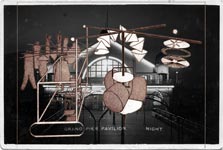|
POETIC LICENCE:
 As “Note 78” suggests, Duchamp envisaged Palmer’s picture in relation to the work in his mind as follows: “In short, a magical (distant) back drop in front of which is presented... the agricultural instrument—.” Following this description it was tempting to use “Grand Pier Pavilion Night” as a background to the eventual “Glass” and particularly its lower male domain with the Bachelor Apparatus, as it was summarily drawn by the artist late in his life in 1965. The poetic license for this daring digital pastiche is provided by the famous line written by the pseudonymous author Le Comte de Lautréamont (aka Isidore-Lucien Ducasse, 1846-1870) to describe a young boy as “beautiful as the chance meeting on a dissecting-table of a sewing-machine and an umbrella.” This line, from Lautréamont’s 6th Song of “Les Chants de Maldoror” (The Songs of Maldoror) of 1869, was often used by André Breton as an example of Surrealist dislocation. As “Note 78” suggests, Duchamp envisaged Palmer’s picture in relation to the work in his mind as follows: “In short, a magical (distant) back drop in front of which is presented... the agricultural instrument—.” Following this description it was tempting to use “Grand Pier Pavilion Night” as a background to the eventual “Glass” and particularly its lower male domain with the Bachelor Apparatus, as it was summarily drawn by the artist late in his life in 1965. The poetic license for this daring digital pastiche is provided by the famous line written by the pseudonymous author Le Comte de Lautréamont (aka Isidore-Lucien Ducasse, 1846-1870) to describe a young boy as “beautiful as the chance meeting on a dissecting-table of a sewing-machine and an umbrella.” This line, from Lautréamont’s 6th Song of “Les Chants de Maldoror” (The Songs of Maldoror) of 1869, was often used by André Breton as an example of Surrealist dislocation.
SUPERPOSITION:
Of course, Duchamp was abstractly expressing an idea. However, the design superposing a particular analogy of the Bachelor Apparatus over the Pavilion’s façade ➇ seems to work well. Included from left to right, in Duchamp’s pun terminology, are the Nine Malic Molds, Chariot, Chocolate Grinder and Oculist Witnesses. All of these components with the exception of the Moulds and the Witnesses were recorded on the first complete perspective layout of the “Glass” to scale that Duchamp drew on the plaster wall of his Paris studio at 23 Rue Saint Hippolyte, in the winter of 1913. This significant preliminary drawing was transferred by pencil on tracing cloth, which is in the Collection Jacqueline Matisse Monnier, Villiers-sous-Grez. Despite the inconsistency of vanishing points, as that of the Pavilion is slightly left of the photograph’s centre, while the other of the Bachelor Apparatus is at the photograph’s central top, the two superposed pictures merge compatibly and create a harmonious composition by today’s postmodern standards. |

